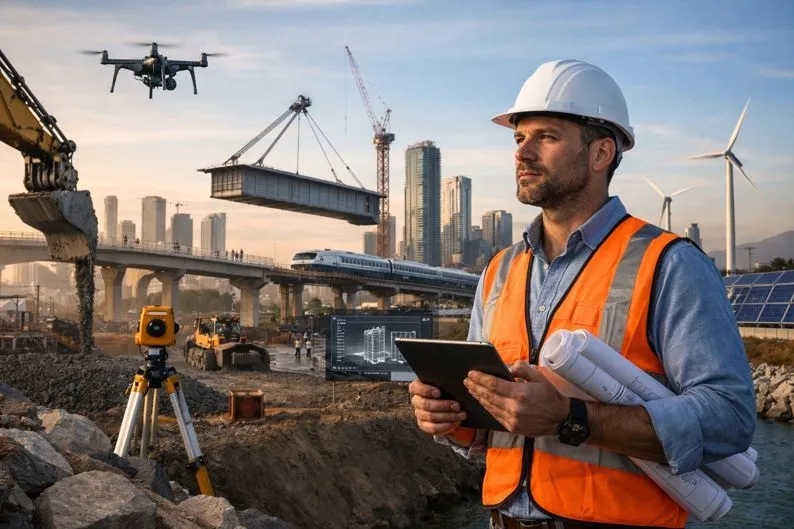The Future of Civil Engineering in 2026 is defined by smarter infrastructure delivery, digital integration across project lifecycles, climate responsive design, and material innovation. The industry is advancing toward systems that are resilient, data driven, and optimized for long term performance as infrastructure demands grow worldwide.
Public agencies and private developers are prioritizing infrastructure that can adapt to environmental stress, population growth, and economic uncertainty. Civil engineering in 2026 focuses on efficiency, durability, and measurable outcomes rather than traditional construction volume alone.
Infrastructure Priorities Shaping Civil Engineering in 2026
Renewal of Aging Infrastructure
A significant portion of civil engineering activity in 2026 centers on upgrading aging infrastructure systems. Roads, bridges, water networks, and public facilities built decades ago are now under pressure from increased usage and environmental stress.
Key focus areas include:
- Structural rehabilitation instead of full replacement
- Load capacity upgrades for modern traffic demands
- Seismic retrofitting of bridges and public structures
- Lifecycle extension through performance based design
According to the American Society of Civil Engineers Infrastructure Report Card, deferred maintenance continues to pose economic and safety risks, reinforcing the need for large scale renewal programs.
American Society of Civil Engineers Infrastructure Report Card
Climate Resilient Infrastructure Design
Climate resilience is no longer a specialized consideration. Civil engineering projects in 2026 are expected to withstand flooding, heat extremes, high winds, and seismic activity.
Resilience strategies include:
- Elevated roadways and transit corridors
- Flood resistant foundation systems
- Advanced stormwater retention and drainage
- Redundant structural load paths
Research from the World Bank shows that resilient infrastructure significantly reduces long term recovery and maintenance costs.
World Bank climate resilient infrastructure overview
Digital Technologies Transforming Civil Engineering
Building Information Modeling as a Core Requirement
Building Information Modeling has evolved into a foundational tool for civil engineering in 2026. BIM is now integrated across planning, design, construction, and asset management.
Current BIM driven practices include:
- 4D scheduling to align construction sequencing
- 5D cost modeling for real time budget control
- Cross discipline clash detection
- Digital asset records for long term maintenance
Infrastructure owners increasingly require BIM deliverables to ensure transparency, accuracy, and operational efficiency.
Digital Twins and Infrastructure Monitoring
Digital twins are reshaping how infrastructure assets are managed. These virtual models mirror physical systems using real time sensor data and performance analytics.
Benefits include:
- Continuous structural health monitoring
- Predictive maintenance planning
- Early detection of performance degradation
- Reduced unplanned outages
Digital twins are commonly used for bridges, tunnels, water treatment facilities, and transportation networks.
Materials and Construction Innovation
Low Carbon and High Performance Materials
Material innovation is a defining factor in civil engineering in 2026. Engineers are adopting low carbon alternatives that meet performance requirements while reducing environmental impact.
Advancements include:
- Low carbon concrete mixes
- Carbon curing technologies
- Recycled aggregates and industrial byproducts
- Fiber reinforced composites for structural efficiency
The International Energy Agency highlights cement production as a major emissions source, accelerating adoption of alternative materials.
International Energy Agency cement and emissions analysis
Circular Construction Practices
Circular construction principles are increasingly applied to infrastructure projects. Designs consider material reuse, adaptability, and end of life strategies from the outset.
Common applications include:
- Modular structural components
- Reusable pavement materials
- Reduced excavation waste
- Lifecycle carbon assessments
These practices improve sustainability while stabilizing material costs.
Automation and Advanced Construction Methods
Robotics and Automated Equipment
Automation is expanding across civil engineering job sites in 2026. Robotics and autonomous equipment are used to improve precision, safety, and productivity.
Applications include:
- Automated concrete placement and finishing
- Robotic inspection in confined spaces
- Autonomous earthmoving equipment
- Drone based surveying and monitoring
Automation reduces labor intensive tasks and enhances project consistency.
Prefabrication and Modular Infrastructure
Prefabrication plays a growing role in infrastructure delivery. Civil engineers are designing systems that allow off site manufacturing and rapid on site assembly.
Benefits include:
- Accelerated construction schedules
- Improved quality control
- Reduced traffic disruption
- Lower exposure to weather delays
Prefabricated bridge elements and utility systems are now standard on many large projects.
Transportation and Urban Infrastructure
Smart Transportation Systems
Civil engineering in 2026 supports transportation networks that are data driven and multimodal. Infrastructure is designed to support public transit, micromobility, and pedestrian movement alongside vehicles.
Design considerations include:
- Smart traffic signal systems
- Integrated transit corridors
- Electric vehicle infrastructure
- Safety focused street design
Real time data analytics help optimize traffic flow and reduce congestion.
Rail and Mass Transit Expansion
Investment in rail and mass transit continues to grow as cities seek sustainable mobility solutions. Civil engineers are addressing complex urban constraints while expanding capacity.
Engineering challenges include:
- Underground construction in dense environments
- Noise and vibration mitigation
- System integration with existing infrastructure
- Long term operational durability
Research from McKinsey indicates that well planned transit systems improve productivity and reduce emissions.
Water and Environmental Engineering Focus Areas
Water Security and Flood Protection
Water infrastructure is a critical priority in civil engineering in 2026. Projects address both supply reliability and flood risk management.
Key areas include:
- Advanced stormwater systems
- Flood control channels and retention basins
- Water reuse and treatment facilities
- Smart water distribution networks
Designs increasingly account for uncertain hydrological patterns caused by climate variability.
Coastal and Marine Engineering
Coastal regions face rising sea levels and erosion, driving demand for advanced marine engineering solutions.
Approaches include:
- Reinforced seawalls with ecological features
- Offshore breakwaters
- Living shorelines
- Hybrid engineered and natural systems
These solutions balance protection with environmental preservation.
Project Delivery and Risk Management
Data Driven Risk Modeling
Civil engineering projects in 2026 rely on predictive analytics to manage cost, schedule, and safety risks. Advanced modeling allows engineers to test scenarios before construction begins.
Benefits include:
- Improved cost certainty
- Reduced schedule overruns
- Enhanced safety planning
- Clearer stakeholder communication
Risk assessment is embedded into early planning stages.
Collaborative Delivery Models
Collaborative project delivery methods are increasingly common. These approaches improve alignment between designers, contractors, and owners.
Key characteristics include:
- Early contractor involvement
- Shared risk and reward frameworks
- Faster design coordination
- Improved constructability
Civil engineers play a central role in integrating technical, financial, and operational considerations.
Civil engineering in 2026 reflects an industry focused on resilient infrastructure, digital integration, and sustainable performance. The discipline continues to evolve through innovation in materials, construction methods, and data driven decision making, shaping infrastructure systems designed to meet modern demands while delivering long term value.
Content reviewed and published by Tier2Tek Staffing Editorial Team .

